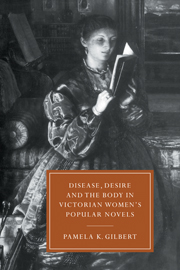Book contents
- Frontmatter
- Contents
- Acknowledgments
- Introduction
- 1 “In the body of the text”: metaphors of reading and the body
- 2 Genre: the social construction of sensation
- 3 M. E. Braddon: sensational realism
- 4 Rhoda Broughton: anything but love
- 5 Ouida: romantic exchange
- Afterword: the other Victorians
- Notes
- Bibliography
- Index
- CAMBRIDGE STUDIES IN NINETEENTH-CENTURY LITERATURE AND CULTURE
1 - “In the body of the text”: metaphors of reading and the body
Published online by Cambridge University Press: 16 November 2009
- Frontmatter
- Contents
- Acknowledgments
- Introduction
- 1 “In the body of the text”: metaphors of reading and the body
- 2 Genre: the social construction of sensation
- 3 M. E. Braddon: sensational realism
- 4 Rhoda Broughton: anything but love
- 5 Ouida: romantic exchange
- Afterword: the other Victorians
- Notes
- Bibliography
- Index
- CAMBRIDGE STUDIES IN NINETEENTH-CENTURY LITERATURE AND CULTURE
Summary
The police and soap … were the antithesis of the crime and disease which supposedly lurked in the slums … [but policing is effected through the gaze of the bourgeoisie, which is then implicated in its object:] If the dominant discourses about the slum were structured by the language of reform, they could not but dwell upon the seductions for which they were the supposed cure … Thus, even as a separation of the suburb from the slum established certain class differences, the development of the city simultaneously threatened the clarity of that segregation … and the fear of that promiscuity was encoded above all in terms of the fear of being touched. “Contagion” and “contamination” became the tropes through which city life was apprehended.
SENSATIONAL BODIES
The body – despised, adorned, represented, medicated, ignored, dissected, and desired – is ineradicably entwined in subjectivity. What we do, feel, believe, know is as embodied beings. The body, uncertainly poised between nature and culture, practices and signifies identity. It is the fundamental trope of human experience.
The body as it has been represented is unlike the lived body in that it is almost never individual. From early anatomies to modern portrait painting, it refers, whether explicitly or implicitly, to a generalized body-template tied to its contemporary notions of health, gender, race, aesthetics, and social position. This tendency is exacerbated whenever one makes reference to “the” body – as in “the” female reader – who, by implication, is embodied as “the” female body, a body with all the characteristic weaknesses and strengths implied in an abstract, non-particularized notion of femaleness.
- Type
- Chapter
- Information
- Publisher: Cambridge University PressPrint publication year: 1997



